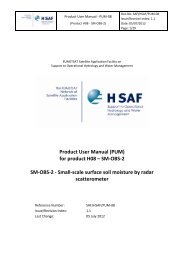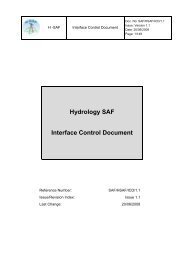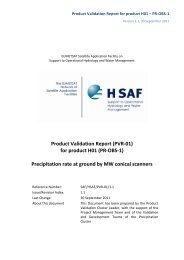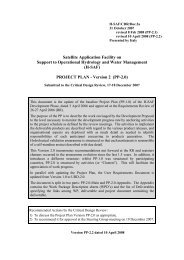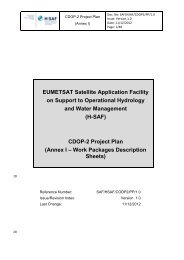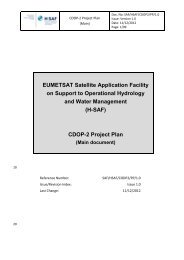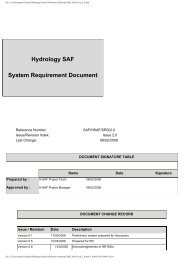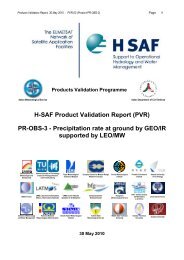Ahmet Ãztopal, Albero Mugnai, Daniele Casella, Marco ... - H-SAF
Ahmet Ãztopal, Albero Mugnai, Daniele Casella, Marco ... - H-SAF
Ahmet Ãztopal, Albero Mugnai, Daniele Casella, Marco ... - H-SAF
You also want an ePaper? Increase the reach of your titles
YUMPU automatically turns print PDFs into web optimized ePapers that Google loves.
A first glance on Figure 5.3 indicates first of all that there is a large difference between thePDF peaks for land and ocean, and it may be as a result of “cold” emission from the seasurface, which is coupled by land surfaces. Additionally, for each frequency there appearsa large difference over ocean between the two polarizations, and it may be due to thehigher ocean emissivity at vertical polarization.Low Frequency Channels pdfs Over Land0.14Occourrence0.120.10.080.060.040.020180 200 220 240 260 280 300Brightness Temperature (K)Ch 19.350 VCh 19.350 HCh 22.235 VCh 37.000 VCh 37.000 HLow Frequency Channels pdfs Over OceanOccourrence0.060.050.040.030.020.010100 120 140 160 180 200 220 240 260 280Brightness Temperature (K)Ch 19.350 VCh 19.350 HCh 22.235 VCh 37.000 VCh 37.000 HFigure 5.3. PDFs of the simulated upwelling TBs in the CRD / CDRD European databasefor the five low-frequency SSM/I – SSMIS window channels over land (top)and ocean (bottom).The graphs in Figure 5.4 indicate the differences between land and ocean as wellas the two polarizations, which are comparatively lower than for the low-frequencychannels. This is as a result of much larger atmospheric contribution to the upwelling TBs.15




